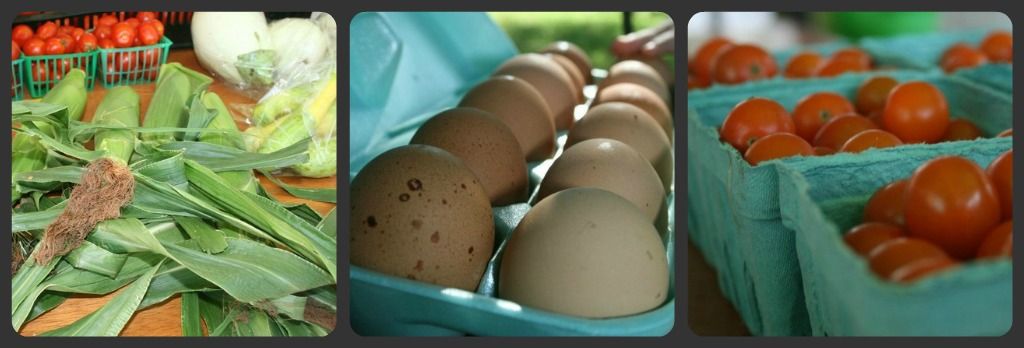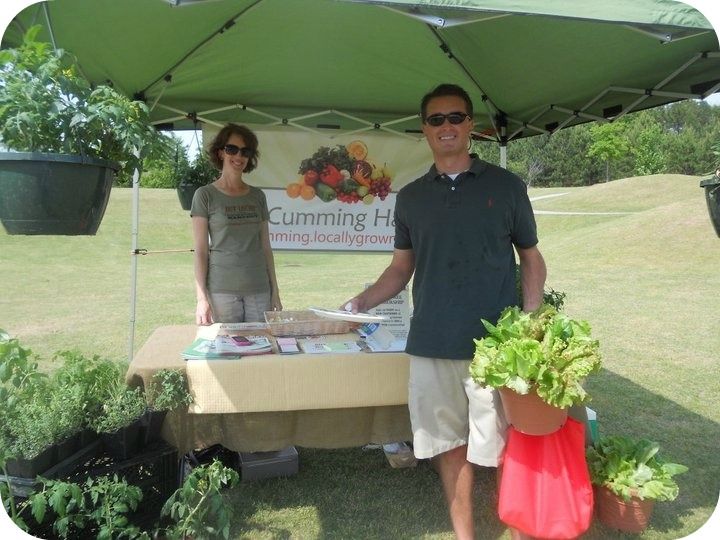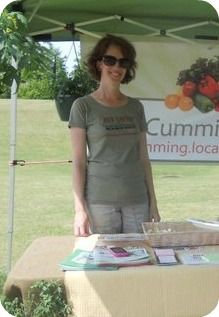The following is a guest post by Contributing Blogger, Clori Rose-Geiger. Clori is an avid cook, co-owner of Mia’s Pizza & Eats in Cumming and a supporter of the farm-to-table movement.
“The Importance of Eating Locally: An Interview with Suzanne Geddes of Cumming Harvest”
Market days are the best days. I love walking amongst the varied stands, seeking out the surprises my favorite farmers have brought, sharing stories of the meals I’ve made, thanking them for their commitment to the health of our community. Summer brings a bounty so rich and intoxicating, I feel that I am knee deep in cooking, grilling, canning, and freezing the entire season. I revel in these summertime markets, family time meal making, connection to the season and the foods that sustain me. As the cool air of fall taps me on my shoulder, the harvests begin to change, and so too does my palette. Recipes for soups, stews, roasts, and baked goods invade my imagination; I’m instinctually drawn to the root vegetables and leafy greens that color the season.
In Georgia we are blessed with a long growing season, so farmer’s markets are plentiful into October, some lasting until December. With the drought and the long heat this year, many farmers have had to make some tough decisions about their fall crops, some having to hang their hats until spring. There are still many more farmers amongst us, trudging through the drought, growing the staples of an autumn harvest, and preparing for their winter crops. These men and women who grow locally and organically are true activists, committed to our families in the most profound way. I am wholeheartedly thankful to each farmer for the tireless and backbreaking effort it takes to bring food to my table. And we have to remember that these farmers don’t simply bring us produce; they bring us meats, honey, eggs, milk, cheeses, yogurt, breads, flowers, and so much more. They are part of a movement going on in this country, a movement to be healthier, a movement to support our local economies, a movement to save the small farmer from the ills of industrialized agriculture. I recently read two books that opened my mind and heart, and I think anyone curious about the local foods movement should read them too: Animal, Vegetable, Miracle: A Year of Food Life by Barbara Kingsolover & The Locavore’s Handbook: The Busy Person’s Guide to Eating Local on a Budget by Leda Meredith.
Farmer’s markets make it so much easier for the consumer to come face-to-face with the producers of their foods, for the farmer to sell their wares, and for busy families to make small changes that make huge impacts both on their families and on their environments. Cooler weather does signal the close of many markets around us, but there is one market in Cumming open year-round: The Cumming Harvest. It is an online market that opens on Wednesdays at 8am, closing Thursdays at 8pm. Customers simply sign up to purchase, make their orders online, and then pick up on Saturdays from 10am to 12pm at the North Georgia Children’s Center on Highway 9. Suzanne Geddes organizes and operates the market each week. I recently interviewed Suzanne, and her answers to five simple questions serve to educate us all about why we should be making the choice to buy and eat locally produced vegetables, dairy products, and meats.
Organic food is the cleanest, purest and most nutrient dense food available. People don’t realize the amount of nutrients that are lost when crops aren’t rotated, when chemicals are sprayed, or when more thought is on the dollar than the food. Dirt is a living thing and big agriculture corporations are killing it. We’re filling our stomachs with “nothing food,” and if we don’t watch out, we’ll eventually be a generation that has no healthy land left to farm and no rights to what we can grow and eat. We’re eating “food” that was created in a lab. We eat what tastes the sweetest, looks the prettiest and costs the least. It seems we’re all doing fine…but are we? Look closer…I’m very passionate about how our food is affecting our children. Our children lack nutrients and are pumped up with sugar, artificial colors and chemicals…they ARE growing and surviving, but to what extent? We now have childhood obesity and record cases of all types of disorders on the autism spectrum. We HAVE to support the small family farmers that are passionate about sustaining the earth, passionate about growing food for others, and passionate about teaching others how to grow their own clean food.
Why local? What is the most compelling reason why moms should feed their families local foods? What draws you to the local foods movement?
Local food is the freshest food you can buy, besides being the highest in nutrition while impacting the environment the least. It hasn’t been sitting on a truck or boat for days being shipped to the store. It isn’t picked before it’s ripe and sprayed with Ethylene gas so it’s ripe when we buy it. It’s picked ripe and ready to eat. Local food is grown by local growers, our neighbors who need our support to keep growing. Keeping money in the state or county is important; however, I feel it’s more about supporting the grower. When customers buy from The Cumming Harvest, growers are paid 90% of their sales. Other than buying directly at the farm, that’s more than they would get anywhere else.
What inspires you about Cumming Harvest — what about it makes you continue to plan and organize it each week? It can’t be an easy task. Can you share a little about the process of making everything happen? What’s the hardest part about making it all work? What’s the best part?
I love opening the market on Wed mornings and seeing that within 15 min 20-25 customers have placed orders. One of the hurdles in managing the market is trying to balance the supply and demand. I’m always working to make sure the growers have enough buyers and the customers have enough selection. During the summer many growers participate in other markets and they aren’t able to deliver to us. But during the winter, when the other markets are closed, the vendors are grateful to have The Cumming Harvest to sustain them. I’m happy that we can stay open all year for the growers and so that the customers have a market they can count on for their families.
Can you talk a little about the farmers? What is it like working so closely with them?
The farmers are the most friendly, hard-working people I’ve ever met. From them, I have learned how much they go through in order to sell their food to the public. There are a lot of regulations when it comes to organic chicken and raw milk for example. Also, growing organic isn’t cheap; not only is it hard work but it’s expensive. There is much more labor involved in working on a small organic farm. Many farmers rely on help from interns and volunteers hoping to learn to grow organic. It’s a totally different way of growing from conventional. Growers have to know the biology of the soil because each plant requires a different quality. There are good bugs and bad, and they have to know how to deal with them. It’s very interesting!
Best piece advice to parents who want to add more local/organic foods to their diets?
Buying organic, locally grown produce is a new experience for most. You will see items on the market that you’ve never tried before, let alone know how to cook. Try it. Ask the grower for their favorite recipe. Don’t buy too much in the beginning or you’ll be overwhelmed and it will go bad before you have time to eat it. However, I’ve noticed a bag of spinach will keep twice as long as even the organic in the store. When making your grocery list for the week, take a look at what’s available online, place your orders, then fill in at the grocery store. Also, the best thing about locally grown organic is that it tastes so much better! I can tell people that all day, but until they try it they’ll never believe me. I never liked tomatoes until I started eating them from the market. Plus, I’ve heard many parents mention that their children have started eating vegetables from the market that they’d never touch from the store.

Fall and winter don’t have to be a time when we pull away from buying locally. It’s the best time to enjoy comforting recipes filled with nutrient rich foods that sooth the soul. Cumming Harvest is a great way to stay connected to the nutrient rich foods North Georgia farmers are growing; order online via the website or stay connected on facebook. If you love the experience of an outdoor market, check out some of the farmer’s markets in Georgia that stay open through the winter.
Here’s an inspirational recipe for a white bean stew filled with ingredients you can find in your cupboard and at the market in the fall.
Autumn Farmer’s Market White Bean Stew
2-3 tablespoons olive oil
1 red onion, chopped
4 cloves garlic, pressed
2 carrots chopped
Bunch of fresh rosemary, chopped
Bunch of fresh sage, chopped
¼ cup cooking wine, I use mirin, a sweet Japanese rice wine
3 cups cooked white beans, I prefer dry beans that have been cooked in the slow cooker overnight.
1 can tomatoes, I prefer my own canned tomatoes, but you can use store bought
2-3 cups prepared chicken broth (I prefer homemade that I keep in freezer, but store bought is fine)
2 cups water
3-4 cups chopped fresh greens (kale, Swiss chard, or spinach work perfectly)
Cooked turkey sausage (I got sweet Italian sausage and made into meatballs that I cooked first)
Juice and zest of two lemons
Salt and pepper
Prepared pesto (as topping to serve)
Freshly grated parmesan (as topping to serve)
Crusty, toasted bread
Saute the onions, garlic, and carrots, rosemary, sage, salt, and pepper in the olive oil until vegetables begin to caramelize. Add the cooking wine to deglaze the bottom of the pan and scrape with a spatula to get up all the yummy caramelized bits. Next add the broth, water, white beans, and tomatoes. Allow the soup to come to a boil and to simmer for about 10-15 minutes. Then add the turkey sausage, chopped greens, and lemon zest/juice. Allow to simmer for 5-10 minutes more. Check the taste and add salt and pepper as needed. Serve with a dollop of prepared basil pesto and freshly grated parmesan with crusty bread on the side.
Stay connected with Clori:
 Email – miaspizzaandeats@hotmail.com
Email – miaspizzaandeats@hotmail.com
Website – www.miaspizzandeats.com
Facebook – www.facebook.com/…Mias-Pizza-and-Eats
Twitter – www.twitter.com/miaspizzaneats
Blog – www.miaspizzaandeats.blogspot.com
Flickr – www.flickr.com/photos/miaspizzaandeats
Tumblr – www.miaspizzaandeats.tumblr.com






I had no idea this was available right in my backyard!! Checking it out now, and can’t wait to be apart of supporting our community!
Awesome Allie! Set up an account today look around & then tomorrow the market “opens” online. It’s super easy to shop then pick up on Saturday morning. Enjoy!!
Copper scrap market demand Copper scrap supply Metal recycling company
Copper cable salvage, Metal scrap collection, Scrap copper inspection
Scrap metal reclamation and utilization services, Copper scrap repackaging, Copper cable recycling statistics, Environmental compliance in metal recycling
Metal recycling and salvage Metal reprocessing Iron scrap reclaiming operations
Demolition ferrous metal recycling, Iron metal repurposing, Metal waste brokerage
Environmentally friendly scrap metal trading Ferrous material recycling community engagement Iron waste reutilization
Ferrous material recycling inventory, Iron scrap import regulations, Scrap metal reutilization
Scrap metal decommissioning Ferrous scrap trade Iron reclaiming operations
Ferrous material shearing, Iron scrap collection points, Metal utilization
Scrap metal collection services Ferrous material transportation services Iron scrap yard management
Ferrous material recovery centers, Iron reprocessing services, Metal reprocessing facility